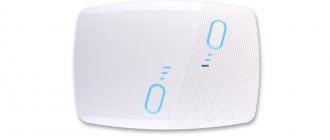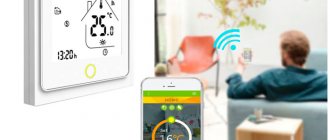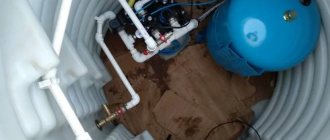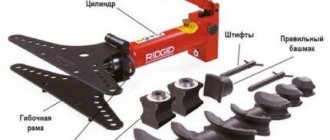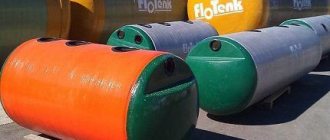There are a variety of heating systems - radiator, pipe, in-floor, baseboard. If in apartment conditions you don’t have much choice. Typically, standard radiators made of materials such as cast iron, steel, aluminum or other metal alloys are installed there. In private homes, preference is increasingly being given to water- or electric-based floor heating systems. Water-based heated floors can be prone to leaks, which can be quite problematic to eliminate. It is for this reason that the owners of such housing install electric heated floors.
Additional 5% discount on Ozon Express products on the table when purchasing over 1,500 rubles using promotional code OZONHBP235 for products from this page!
Such products have low energy consumption and can be installed under a variety of surfaces - laminate, linoleum, ceramic tiles, even wooden floors. One of the key elements in such a system is the thermostat. Without it, it will not be possible to set the optimal temperature in the room. It is built into an ordinary electrical network and, due to the built-in rheostat, determines the specific power attributable to the heating elements.
Unfortunately, not all consumers know how to choose the right device. In this article, we will talk about the best thermostats for heated floors. However, before we begin to analyze specific models in detail, let's look at a number of rules that you need to rely on when purchasing these products.
Thermal sensor operation
The thermostat is necessary for programming and regulating the energy supply of the STP. The thermostat system consists of two sensors and a device for adjusting the heat supply.
As soon as the floor heating system is activated, the device automatically turns on and stops functioning when turned off. The presence of a thermostat allows you to maintain the required temperature, comfortable for the room.
- The thermostat not only controls the temperature, but also significantly reduces energy consumption. Using a thermostat, it is possible to automatically turn on and off the heated floor system.
- Using a thermostat for heated floors is not difficult; a teenager can handle this task. With its help, you can change the temperature supply several times a day. This will not affect the operation in any way and will not disable the underfloor heating system.
Some thermostats have a function to change the temperature of the STP during the day. In each room, using a thermostat, you can set a different temperature, depending on the type of room.
Differences in thermostats depending on the control method
To control the operation and heat transfer of a heated floor system, a thermostat is used, which externally does not exceed the size of a standard switch. The type of control can be either mechanical, electronic or programmable.
Cost-effectiveness of thermostats
Installing a thermostat can significantly save energy, but the degree of savings depends on the type of device.
For small rooms such as a bathroom, toilet, hallway, it is recommended to use a simple thermostat with a minimum of functions - a mechanical model is quite suitable. It should be warm there both day and night, so adjusting the schedule will not be necessary. But in large rooms - living rooms and bedrooms - it will be more effective to install a programmable controller, with which you can set different temperatures for different times of the day and days of the week. The more accurately you configure its operation, the more you can save.
Experts say that non-programmable thermostats can save energy up to 30%, and programmable thermostats can save up to 70%.
Thermostats can significantly save energy - especially if they are programmable
Mechanical temperature sensor
A mechanical thermostat does not have an electronic display or other components. Installing a mechanical thermostat requires a little knowledge and time, since the STP is connected to the sensor by connecting electrical wires.
A mechanical thermostat consists of a switch and a rotating temperature control axis. A switch allows you to turn off the energy supply to the heated floor without resetting the settings.
The thermoregulation mode occurs due to a metal plate made of two metals, connecting two wires to each other in a state of rest (cold plate). When heated, the plate bends, stopping the flow of current from one contact to another, thereby cooling the system.
The advantages of a mechanical thermostat include:
- Affordable price;
- Ease of use;
- Working in a room with low temperature;
- Strength, safety;
- Tolerates sudden temperature changes well;
- Long service life;
- It turns on automatically if the electricity is turned off and then back on.
Despite their simple design, mechanical thermostats are popular due to their safety, reliability and ease of use.
Step-by-step installation instructions
For the thermostat to work and accurately determine the temperature, it is not enough to choose it correctly; it is also important to install the device correctly. Installation usually does not cause problems, but we decided to clearly explain this.
Regardless of which regulator you decide to install, you should start by choosing a location for it. It should be convenient to use. It is necessary to calculate so that the device is located close to the sockets and doors, the height from the floor is 1.5 meters. It cannot be mounted near a window.
Usually, the thermostat kit includes instructions that you need to read.
Sequencing:
- Before starting work, the installation site is de-energized;
- the wires from the heated floor must already be connected to the socket box;
- then the sensor is installed - it is placed in a corrugation, one end is brought out into the socket box, and the second is located between the heaters (cable or infrared film floor plates);
- insulation is removed from the floor wires - 6 cm;
- the cable screens are connected to the yellow-green wire, then everything is placed in the socket box;
- the top panel of the thermostat is removed - you need to insert a straight screwdriver into the groove from below, pressing the lid will snap off;
- the floor wires are connected to the required terminals of the regulator according to the diagram;
- the wires are carefully bent, the device is inserted into the socket;
- the frame is installed and the top panel is attached.
The floor heating thermostat is connected, all that remains is to check its operation.
Electronic thermostats
Outwardly, they are similar to mechanical ones, but have a display or more advanced functionality. They operate on batteries, so the display is not backlit, and in the absence of additional lighting it is difficult to change settings.
The design of the electric thermostat consists of:
- Frame;
- Control chip;
- Sensor external or built-in;
- Power supply and cut-off mechanism.
You can adjust the temperature on the electronic thermostat using the touch screen, control buttons or wheel. There are models on sale that combine several types of controls.
The advantages of an electronic thermostat include:
- You can install the thermostat far (in another room) from the STP;
- The display shows the set settings and the current floor temperature;
- Multi-zone heating control;
- Temperature settings with degree precision;
- If the system malfunctions, the display shows a breakdown;
- Installation of the thermostat away from the STP.
When choosing an electronic temperature sensor, you can use models from different manufacturers. Connecting a thermostat for a heated floor can be done with various STP companies.
Electronic thermostats also have disadvantages:
- With sudden changes in voltage, the performance of the microcircuit changes;
- When there is a power outage, the specified settings are lost;
- The price is higher than mechanical thermostats.
The price difference between mechanical and electronic temperature sensors varies from 15% to 20%. If we exclude the possibility of a power outage, the choice will be based on the appearance that is more suitable for the design of the room.
The choice of an electronic thermostat is based on its more advantageous appearance; the backlit display looks more stylish.
Instructions for the heated floor thermostat are included in the kit. If you study it in detail, there will be no problems with installation. If necessary, seek help from a specialist.
Review of the best thermostats
To control underfloor heating systems, you cannot do without thermostats. They are installed in every room, but if the area is small, then one per apartment is enough.
There are a variety of regulators on sale from different brands: mechanical, electronic, programmable, single or multi-channel, wall-mounted or rail-mounted, so the choice is difficult.
We will consider popular models from trusted companies that combine price and quality, this will make your choice easier.
Teplolux TR 520
Telux TR 520 is an inexpensive model. It is not difficult for them to adjust the temperature level of the heated floor. The device is an electronic programmable type, so it is possible to program it in advance to turn on, and when you find yourself at home, it will be warm there.
The regulator has a graphic display, it reflects the selected programs and the heating degree in the room at the given minute. A temperature sensor and user-friendly interface make settings easy.
Main characteristics:
- minimum temperature level - 5 degrees, maximum - 35;
- power - 3500 W;
- communication current - 16 A;
- Warranty period - 3 years.
Pros of the model:
- low price;
- beautiful display - will fit into any room;
- the ability to adjust the heating level for any day;
- “anti-freeze” mode;
- Air temperature adjustment is available.
Disadvantage: after disconnecting, you need to configure it again.
The thermostat is suitable for electric and water heated floors.
National comfort 711
The model is inexpensive and has a rich set of equipment. The set includes a floor and air temperature sensor, a large graphic display that is backlit. The regulator has a self-diagnosis function, its results are reflected on the screen. Warranty period - 1 year. The device saves up to 30% resource.
The negative aspects of the model are low protection, so it is not recommended to choose it for a bathtub or shower; problems may also arise when pressing the buttons (as they are not very well located).
Varmel RTC 70.26
Electronic wired mechanical thermostat, it is easy to adjust the heating degree quite accurately. There is a wheel with divisions for adjustment. Designed for both electric floors and water systems. Operates at a minimum temperature of 5 degrees, maximum - 40. Permissible load level - 3600 W. Warranty - 1 year.
Installation is carried out in an installation box. Among the advantages are the on and off buttons. There is a remote type sensor with a 3 meter wire. Minus - produces a clicking sound when switching.
Thermo Thermoreg TI-200
A simple, cheap device with an indicator and a temperature sensor. With it you can quite accurately adjust the desired heating level and maintain it. The heating indicator is set on a scale, and the presence of a two-pole switch makes it easy to turn off the regulator.
Mechanical type device. Operating temperature from 5 to 40 degrees. Maximum load - 3600 W. Guaranteed service life 3 years.
This type has many advantages - it is compact, low cost, easy to operate, and has an “anti-freeze” function.
Disadvantages - the inability to adjust heating by day of the week, lack of a display.
Terneo SX
This thermostat for heated floors is “smart” and equipped with a touch panel. It is chosen when remote control is required, since it can be controlled via a smartphone. The interface is simple, which makes it easy to configure.
Hysteresis can be adjusted to reduce the number of switches on and off. Installation is simple - it is installed in a metal box on the wall.
Terneo SX has a number of useful functions: timer, child lock, departure mode. The device is equipped with a temperature sensor.
Main characteristics:
- temperature level from +5 to +45;
- thermostat power 3000 W;
- Warranty period - 3 years.
The advantages include low price, ease of operation, fast response of the screen to touch, and the ability to track statistical data on operation and electricity consumption.
Disadvantages - connection to a smartphone is not made the first time, low-quality plastic.
SpyHeat ETL-308B
The mechanical thermostat is compact in size, easy to use, high quality, and inexpensive. It has a pleasant appearance and works for a long time without interruption. The case is equipped with a temperature switch, an indicator, and a shutdown button. The setting is carried out by turning the switch.
The disadvantage is a possible clicking sound when the heating relay is activated.
Characteristics:
- minimum temperature - 15 degrees, upper limit - 35;
- maximum power - 3600 W;
- there is a temperature sensor;
- service life - 2 years.
Rexant R70XT
Inexpensive compact mechanical wired thermostat with simple controls. The switch operates smoothly, which allows you to change the heating degree by one division. The case has a system power-on indicator. The device is mounted in a distribution box. The regulator is reliable and will last a long time.
Settings available within the range of +5 - +35 degrees. Power level 3500 W. Warranty period - 1 year.
Nest Learning Thermostat 3.0
This model is the third generation of this type. Externally, the regulator is no different, only it has a larger disk size and higher resolution (320 by 320 piculs).
The device is equipped with a large display and new functions: auto schedule, programming, auto shutdown, notification in case of regime violation. Management is simple, possible with a smartphone via the Internet. Installation is also quite simple. Warranty - 2 years.
The only downside is the high price.
Menred RTC 70.26
Inexpensive thermostat for mechanical electric floors with hidden installation and remote sensor. Wired control, with the ability to regulate floor heating.
Maximum load - 3600 W, temperature range from 5 to 40 degrees. The thermostat is equipped with a light indication. Warranty - 3 years.
Installation of the device is simple; it is installed in a mounting box.
Grand Meyer HW500
A universal, inexpensive electronic model of a programmable type controller, controlled by buttons, they can be locked. Has several modes. Equipped with thermal sensors - built-in and wired, working together and individually.
The backlight turns on automatically and turns off after 20 seconds. The advantage of the view is that the settings are saved when turned off. The device is compact, but despite this, the design is modern with a bright display. There is an option to adjust the air temperature.
The disadvantages include a click when turned on, no locking when the mode is off.
Operating temperature fluctuations are 5 - 35, it is possible to increase the limits to +99. Power 3600 W, communication current 16 A. Warranty period 2 years.
Electrolux ETA-16
This electronic device has a small display and a minimum number of icons. The screen glows brightly and lights up when you touch any button. The interface is clear, it is easy to set the regulator to turn off, set and maintain heating at a given level. The device is equipped with a temperature sensor.
Externally, the regulator is made in a modern way, so it will not spoil the design of the room.
The temperature can be set from 5 to 50 degrees. And the permissible power is 3500 W. Warranty period - 3 years.
Devi Touch
The model is suitable for underfloor heating and heating systems. It has a load limit of 3680 W. Microprocessor control unit, touch display. Operating temperature level from 5 to 45 degrees. Warranty - 5 years.
The Devi programmable thermostat has many options - frost protection, absence of people in the room, open window. The advantage is that it saves electricity, which allows you to significantly reduce heating costs. It is possible to adjust the air temperature level. In addition, the device is multifunctional and easy to set up.
The disadvantage is that the instructions are unclear; they do not show the principle of connecting the cable to the regulator.
Caleo 520
A surface-mounted device with a control sensor. It has a backlit display that shows the temperature. Equipped with an additional function - keypad lock.
You can note the simplicity of the setup process and ease of use, as well as the low power of the device. Temperature range from 0 to 40 degrees. Warranty period - 2 years.
Additional advantages include reasonable price and modern design. Disadvantages noted by users are relay clicking.
Almac IMA-1.0
Almac IMA-1.0 is a modern, electronic, inexpensive, high-quality device. Its purpose is warm floors and air conditioners. Equipped with temperature sensors - portable and built-in.
It is easy to adjust the temperature. A positive feature is that the hysteresis can be adjusted; the lower and upper temperature limits are set with high accuracy.
Technical indicators:
- limit temperatures - from -50 to +110 degrees;
- power - 3600 W;
- warranty - 1 year.
Programmable temperature sensors
It surpasses this type of temperature sensors with its more advanced functionality. In different rooms, you can set different operating modes of the STP or change the temperature of the heated floor during the day.
- A programmable temperature sensor allows you to regulate power consumption. In the settings, you can set the operating mode only when people are at home.
- They are equipped with an additional function for controlling the system via a mobile application using the Internet.
- The cost may vary depending on the quality of the display and the functionality of the thermostat.
The main disadvantages are the difficulty of operating the system without experience with electronics. And the high price of the temperature sensor. Functionality, main disadvantages and advantages are similar to other thermostats
The diagram of the heated floor thermostat is shown in the photo.
Voting for the best thermostat for heated floors with Aliexpress
Which thermostat would you choose for underfloor heating on Aliexpress or what would you recommend?
MoesHouse ZigBee Thermostat
33.33% ( 1 )
Aleleke Zigbee thermostat with radiator valve
0.00% ( 0 )
Raychem 1244-017312 Green Leaf
0.00% ( 0 )
POER PTC10
0.00% ( 0 )
Thermostat Tem 13 MC6
33.33% ( 1 )
AVATTO WT160, Wi-Fi
0.00% ( 0 )
Livolo thermostat for floor heating
0.00% ( 0 )
Thermostat Beok TR9B Tuya
0.00% ( 0 )
BHT-002-GCL (ZIGBEE)
0.00% ( 0 )
Smart thermostat AVATTO Tuya with Wi-Fi
0.00% ( 0 )
Nashone 10k temperature sensor
0.00% ( 0 )
MINCO HEAT M6.716
33.33% ( 1 )
Sardo ST-0618RS
0.00% ( 0 )
LCD16A 230 V
0.00% ( 0 )
X7H TuYa Smart Wi-Fi
0.00% ( 0 )
RTC 70.16
0.00% ( 0 )
Smart thermostat with remote control
0.00% ( 0 )
MINCO HEAT M5.16 220 V 16 A
0.00% ( 0 )
Mechanical room thermostat 220 V 6 A
0.00% ( 0 )
Photo of a thermostat for heated floors
How to set up a thermostat
If you have a non-programmable thermostat, everything is quite simple: you just need to turn the switch to set the desired temperature, or do it using the buttons. In this case, the warm floor will simply heat up to a certain temperature.
With programmable models, everything is somewhat more complicated, but at the same time more convenient. You can set it up so that by the time you wake up in the morning or come home from work, the floor is already warm. In other words, you can make the system work in the morning from 6:00 to 8:30, and in the evening from 18:00 to 24:00. The rest of the time, the “warm floor” will be turned off, and this will save energy. By the way, different settings can be set by day of the week - for example, so that on weekends the heated floor works throughout the day.
You can set the thermostat so that the heated floor turns on at a certain time
When setting up any programmable thermostat, you must follow a certain sequence of actions. Below we offer a general scheme of actions, and you can find more specific steps in the instructions for your device.
- Set the day of the week and current time.
- Check in the menu which temperature sensor is enabled. Usually, by default, only the air temperature sensor is activated, but if there are several, we recommend that you also enable the remote floor temperature sensor - this way the temperature will be more accurate.
- Select the section for setting time periods in the menu. Typically, programmable models have 4 periods: “Morning”, “Night”, “At Home”, “Away”. Select one of them, set the exact time of the period, set the temperature and confirm your choice.
- The same should be chosen for weekends. You can configure the thermostat so that the heated floor works from morning to evening, and at night it is turned off or works at “minimum”.
Some thermostats have sensors for the temperature of the heated floor and the general temperature in the room.
You can also select manual mode so that the heated floor has a constant temperature until you change it. Although programmable thermostats may seem expensive, they are still worth investing in because they can save you a lot of energy.
Video - How to set up a thermostat
Installing the Thermostat
Before installation, it is necessary to draw a sketch, where the location of the sensor should be planned at a distance of at least 50 cm from windows and doors and only on internal walls. Up to three heating mats can be connected to the device.
If a room's electric underfloor heating system requires more than three heating mats, calculate several thermostats accordingly. The sensor must be between two heating cables, use the existing power connections to connect the power cord.
During installation, you need to perform the following steps step by step:
- In the pre-drilled groove in the wall and floor, install the thermostat and heating mat cables.
- Then place the temperature sensor between them (the curvature of the line must have a radius of at least 6 cm).
- After cleaning the surface, it is recommended to prime the ceiling for better adhesion.
- After laying, press the mats firmly to the base for optimal fixation, and attach the thermostat to the contacts.
- Then you need to fill the space with screed.
Before screeding and finishing work, you need to check the resistance with a multimeter. Before turning on the thermostat, you need to wait 8-10 days until the screed is completely dry.
Installation and connection of electric heated floors
How to lay thin heating mats correctly - with the mesh down or up? They do it differently in different video instructions.
Can be laid either with the mesh down or up. It is very convenient to lay the heating mat like a carpet on the floor (mesh side down). But on the other hand, the mat may lie unevenly after being in a twisted state for a long time and turning it over can solve this problem. It is also worth noting that some manufacturers specially make the mesh adhesive to simplify installation.
Design and arrangement of electrical cables
A heated floor system, mounted from an electric cable or using infrared film, consists of a number of elements:
- heating cable, which is a source of thermal energy;
- a temperature sensor that records the degree of heating of the wires;
- a thermostat responsible for connecting all the component elements into a common structure and regulating the switching on/off of the floor in accordance with the heating temperature of the cable.
The thermostat or thermostat looks like a small switch. It is intended to adjust the voltage that is supplied to the wires. Connect this device to a standard electrical network using phase and neutral wires.
The thermostat regulates the voltage automatically. It is supplied directly to the heating cable after the floor in the room has cooled. The degree of its heating is monitored by a temperature sensor, which is mounted near the wires and filled with cement mixture.
Residents independently set the temperature at which the floor surface heating system should turn on. The cable used to equip such a heating structure can be resistive and self-regulating. The latter of them independently reacts to temperature fluctuations and changes the resistance level. In turn, a resistive cable does not have such functions.
When calculating the operating parameters of the heating system, and during installation, one must not forget that the length of some types of cables must be certain. If they are shortened, then the degree of heating and current readings may change, as a result of which the wires will begin to function incorrectly and the insulation on them will begin to deteriorate.
When arranging the system, either a single two-core cable or two single-core cables are used, which are arranged in parallel. The first of them is a mesh of wires with a plug on one side. It is unacceptable to cut it and lay it in a screed in places where large pieces of furniture or equipment will be located.
In turn, single-core cables can be cut and nothing bad happens to the insulation. In the same way, infrared floors are trimmed in accordance with the area of the room that requires heating.
Saving money
If the heated floor is turned on constantly, the energy consumption will also become constant. Naturally, you will have to pay for the extra expense. Therefore, the cost savings on purchasing and installing a regulator will quickly be offset by electricity costs.
Carpet on IR film
Another point is floor coverings. If the same laminate or linoleum begins to deteriorate, a complete replacement of the coating may be required. And to do this you will have to remove the old covering, prepare the base, buy new material and lay it. It turns out that saving on connecting a heated floor to a thermostat leads to significant and unexpected costs.
Thus, the use of a heated floor circuit without a thermal relay is unjustified. Moreover, in addition to discomfort and inconvenience of use, this will inevitably lead to additional expenses. So it is much better to install this device initially and not think about possible problems.
Average score of ratings is more than 0
Share link
Comments There are no comments yet, but you could be the first...
